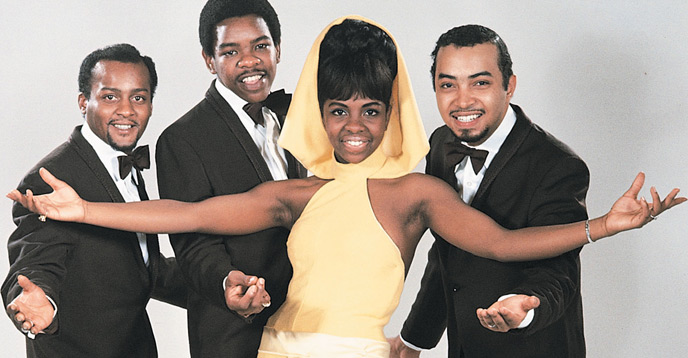7 Facts On R&B Favorite : "I Heard It Through The Grapevine"
"I Heard It Through The Grapevine" was birthed at Motown Records by songwriters Norman Whitfield and Barrett Strong in 1966. It would pass through many hands before the track landed with Gladys Knight & The Pips.

Here's how the would-be classic passed through many hands at Motown before it landed with Gladys Knight & The Pips

As they say, the rest is history!

Here's how the would-be classic passed through many hands at Motown before it landed with Gladys Knight & The Pips
"Instead I heard it through the grapevine/Oh, not much longer would you be mine/Oh, I heard it, yes, I heard it (heard it through the grapevine)/Oh, just about, to lose my mind"
Released in 1967, Knight's retooled up-tempo version of "I Heard It Through The Grapevine" landed at No. 1 on the Billboard R&B charts and placed at No. 2 on the Billboard Hot 100 just behind the Monkees' "Daydream Believer," paving the way for later versions such as Gaye's 1968 recording and Creedence Clearwater Revival's 1970 interpretation.
The tune also earned the distinction of being inducted into the GRAMMY Hall Of Fame as part of the class of 2018, an honor recognizing significant recordings that have shaped our musical heritage.
Though Gaye's version often gets the most attention, let's take a look back at seven facts about Gladys Knight & The Pips' soulful stylings on the chart-topping favorite.
1. History Of The Grapevine
Singer/songwriter Barrett Strong is the mastermind behind the lyrics in the song. After strolling the streets of Chicago and hearing the phrase "through the grapevine," he was inspired to coin the classic term in a song. Working with producer Norman Whitfield, the pair put the words to an arrangement and crafted a narrative that describes a romantic betrayal. But the history of the "grapevine" has deeper roots. During the Civil War era, slaves communicated using the "grapevine telegraph" to pass along vital information using word of mouth.
2. "Out-Funking" The Queen Of Soul
Gladys Knight & The Pips were the third artist at Motown to take a crack at recording "… Grapevine" following Robinson and his Miracles and Gaye. While the previous two records had a smoother, slower vibe, Strong and Whitfield pumped up the funk, soul and gospel for Knight's version. The reason? Aretha Franklin had just released her smash "Respect," and according to author David Ritz, Whitfield wanted to "out-funk" Franklin.
3. Tuning The Track To Gladys Knight
With the track's new upbeat groove, Strong, Whitfield, Knight, and the Pips still needed to do a little retooling on the track. First, the song needed to come from a woman's perspective, which resulted in lyric change, such as altering the first line of the second verse: "I know a man ain't supposed to cry/But these tears I can't hold inside" became "Take a good look at these tears in my eyes/Baby, these tears I can't hold inside." Rearranging "I Heard It Through The Grapevine" took several weeks before it was finally ready to record.
4. Berry Gordy's Reluctance
Motown label head Berry Gordy had already shelved the previous two versions of "I Heard It Through The Grapevine" as singles when Knight's version crossed his desk. Again, Gordy initially didn't want to release it as a single, but after much discussion he reluctantly agreed. The song was finally released Sept. 28, 1967, on Motown's Soul Records label. It was also added to the group's 1967 studio album, Everybody Needs Love.
5. Career Breakthrough
Gordy's reluctance to release the track trickled into its promotion. In fact, Motown put almost no effort behind "I Heard It Through The Grapevine" after its release, and the Pips relied solely on their connections with radio DJs across the country. Their persistence paid off. Not only did the record spend six weeks in the top spot on Billboard's R&B charts, it rocketed to No. 2 on the Billboard Hot 100, becoming Motown's biggest hit at the time.
6. Paving The Way For Marvin Gaye
While Marvin Gaye technically recorded his version of the song first, Gordy refused to release the emotional down-tempo track until after Knight had such big success with it. Gaye's "I Heard It Through The Grapevine" was released in 1968, and it surpassed all expectations, outselling Knight's version. He received a GRAMMY nomination for the song at the 11th GRAMMY Awards, and Gaye's rendition was inducted into the GRAMMY Hall Of Fame in 1998. Gaye's success caused tension between him and Knight, though they worked out their animosity later in their careers. But arguably, Knight's version paved the way for Gaye's "… Grapevine" good fortune.
7. Other Notable Covers
The mega success of "I Heard It Through The Grapevine" led to other notable covers, particularly Creedence Clearwater Revival who took the song to another level with an 11-minute showdown on their 1970 album, Cosmo's Factory. Funk artist Roger Troutman also included the track on his 1981 solo album, The Many Facets Of Roger, and Amy Winehouse, the Temptations and Elton John have all gotten their hands on it. "… Grapevine" also formed the foundation for Queen Latifah's 1998 single "Paper."
CREDIT: RENÉE FABIAN
GRAMMYS
 |
| mypublicist.biz |
Comments
Post a Comment